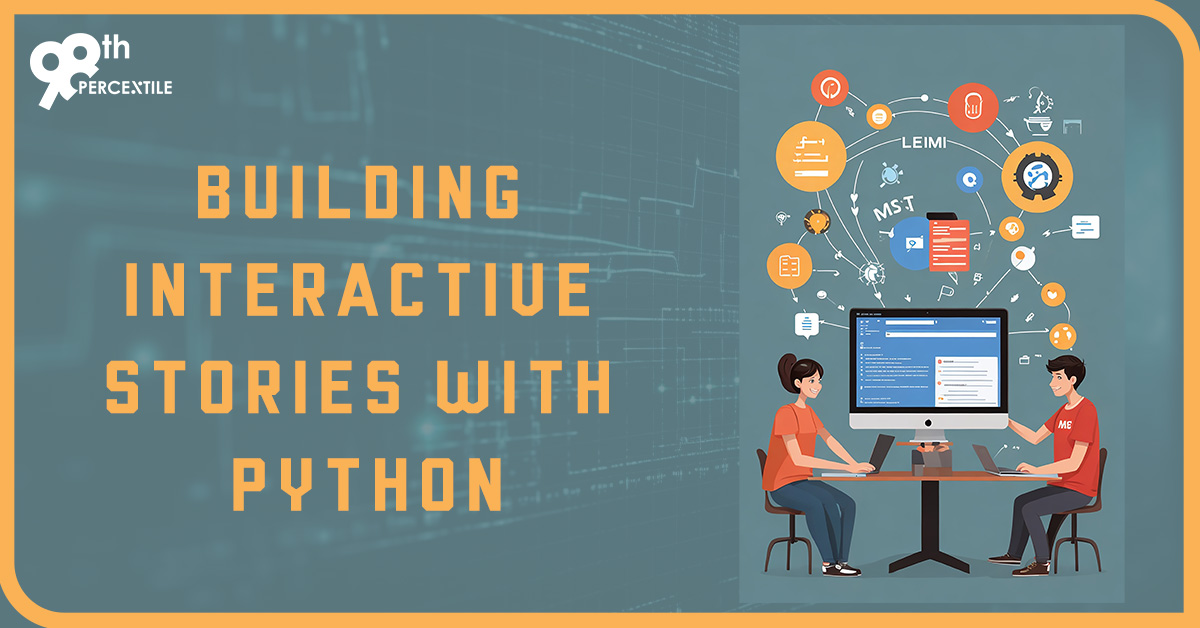Imagine being able to create your own stories where you, as the reader, can make choices that shape the outcome of the tale. Whether it's a thrilling adventure in a mystical land or a mystery-solving mission in a haunted mansion, interactive stories let you be the hero of your own adventure. In this blog, we'll explore how to build interactive stories with Python, a programming language that's not only fun to learn but also incredibly powerful.

What are Interactive Stories?
Interactive stories are a unique form of storytelling where the reader becomes an active participant in the narrative. Instead of simply turning pages, you make choices at various points in the story, and those choices determine the direction the plot takes. These choices could lead to different endings, and characters' fates, or even unlock secret paths and hidden treasures.
Interactive stories are like regular stories, but with a twist - you get to make choices that affect the outcome! It's a bit like those "Choose Your Own Adventure" books, but better because you can craft your own unique narratives.
Imagine being the hero of a story, exploring mysterious caves, solving puzzles, and making decisions that shape the plot. These stories are all about you and your choices. And guess what? Python can help you bring these stories to life!
Why Python?
Python is an awesome programming language, and it's perfect for beginners like you. It's easy to learn, read, and write. Plus, it's used in lots of cool fields like game development, web design, and even artificial intelligence! Learning Python is like gaining a superpower. With it, you can create games, make websites, analyze data, and, of course, build interactive stories. So, let's get started!
Getting Started with Python
Before we dive into creating interactive stories, you'll need to set up your Python environment. Here's a step-by-step guide:
1. Install Python:
Visit the official Python website (https://www.python.org/downloads/) and download the latest version of Python for your operating system. Follow the installation instructions.
2. Choose a Code Editor:
You can write Python code in a plain text editor, but it's more convenient to use a code editor specifically designed for coding. Some popular options include Visual Studio Code, PyCharm, and Thonny.
3. Let's Write Some Code:
To get you started, here's a simple Python program that greets you. Open your code editor and type the following:
code :- print("Hello, young storyteller!")
Save your file with a ".py" extension (like "hello.py") and run it. Voilà! You've just created your first Python program.
Building Your Interactive Story
Now, let's jump into the exciting part - creating your interactive story with Python. We'll start with a basic example where you'll decide whether to go on a magical quest or explore a spooky forest.
CODE
print("Welcome to the Interactive Story!")
print("You stand at a crossroads.")
choice = input("Do you want to go on a magical quest (Q) or explore the spooky forest (F)? ").upper()
if choice == "Q":
print("You embark on a magical quest with a brave heart.")
choice2 = input("Do you choose the path of wisdom (W) or the path of courage (C)? ").upper()
if choice2 == "W":
print("You acquire great wisdom and become a wise sorcerer.")
print("The end.")
elif choice2 == "C":
print("You display immense courage and become a legendary knight.")
print("Congratulations, you win!")
else:
print("Your indecision led you astray. Game over.")
elif choice == "F":
print("You enter the spooky forest filled with mystery and danger.")
print("The end.")
else:
print("Invalid choice. Please restart the game.")
In this code, we use the input() function to get your choice and if statements to determine what happens next based on your decision. You're already on your way to creating your own interactive story!
Taking Your Story to the Next Level
Once you've got the basics down, you can level up your interactive story in so many ways. Here are some cool ideas:
1. Create Unique Characters:
Design your own characters with personalities, strengths, and weaknesses. Let the readers shape the characters' destinies through their choices.
2. Add Visuals:
Make your story visually appealing by incorporating images and graphics. You can do this with Python libraries like Pygame and Tkinter.
3. Surprise with Randomness:
Keep your readers engaged by adding random events or unexpected encounters. Python can generate randomness, adding an element of surprise to your story.
4. Save Progress:
Implement a save feature so readers can come back to your story later. This involves learning about file handling in Python, which is a handy skill to have.
Conclusion
Building interactive stories with Python is not only a creative and fun way to learn programming but also a fantastic way to share your imaginative worlds with others. The possibilities are endless, and the only limit is your creativity. So, are you ready to embark on your coding adventure and craft your own interactive stories? Python is your trusty companion on this journey, ready to turn your ideas into interactive narratives that captivate and inspire. Happy coding and storytelling! Check out 98thPercentile for more!

 Students/Staff
Students/Staff Parents
Parents ElevatEd
ElevatEd













